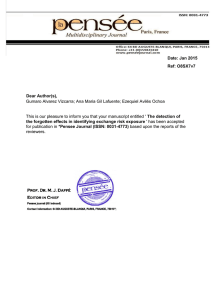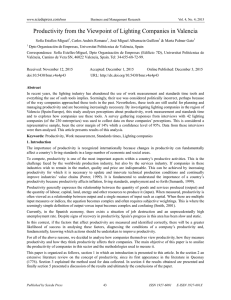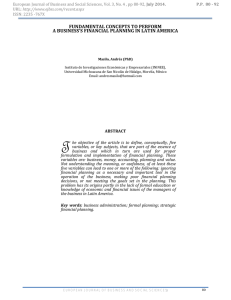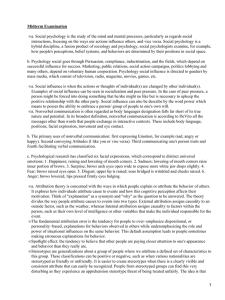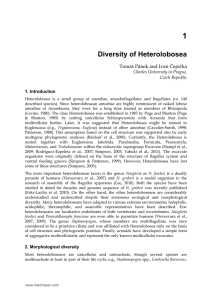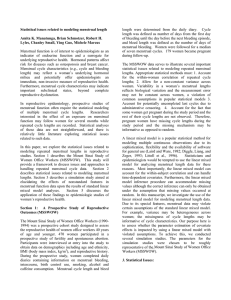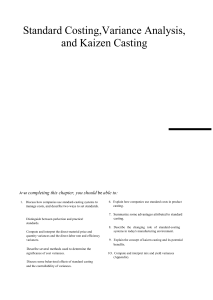Dimensions for evaluating university quality in the European Space
Anuncio
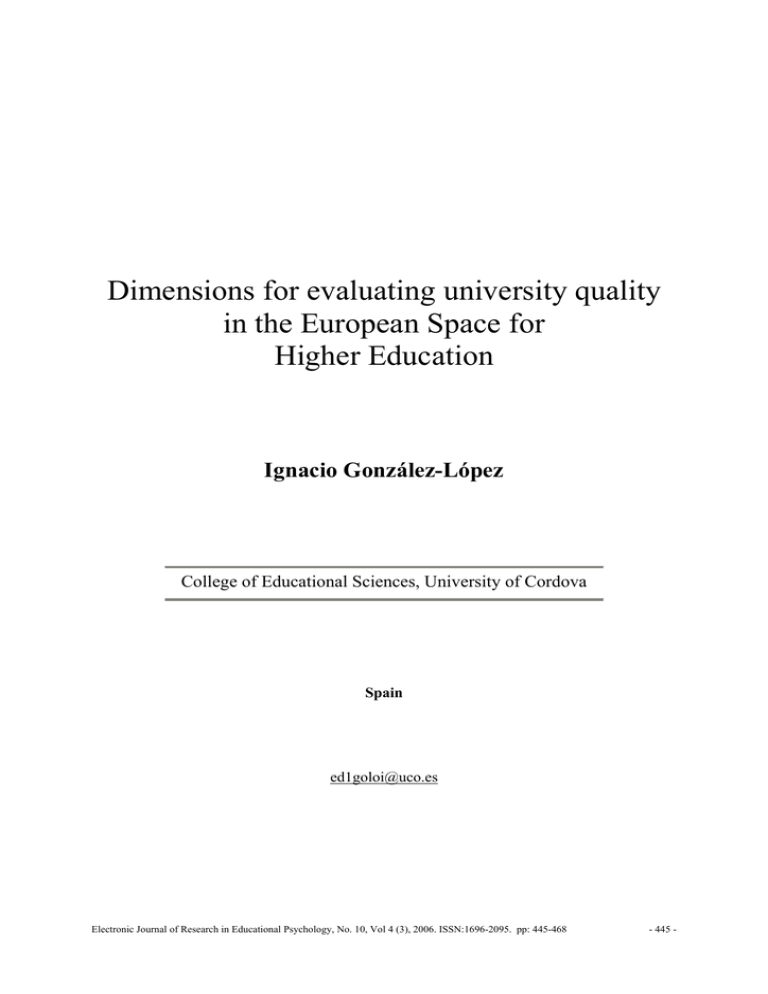
Dimensions for evaluating university quality in the European Space for Higher Education Ignacio González-López College of Educational Sciences, University of Cordova Spain [email protected] Electronic Journal of Research in Educational Psychology, No. 10, Vol 4 (3), 2006. ISSN:1696-2095. pp: 445-468 - 445 - Ignacio González-López Abstract Introduction: This paper seeks to establish basic dimensions on which to construct a system of indicators for evaluating university quality, from the perspective of pupils, and within the framework offered by the European Space for Higher Education. Method: The population for this study was defined as the set of students enrolled at the Universities of Salamanca (USAL) and Cordova (UCO) in the academic year 2004/2005, a total of 45,751 students. The two institutions are located in diverse geographies within the territory of Spain, and each has a distinct identity. The sample obtained comprised a total of 1167 subjects, stratified as a function of branch of specialization: health sciences, humanities, legalsocial studies, and technical programs. A questionnaire was designed to collect information using a protocol of scale-based evaluation items. Application of factorial analysis allowed us to establish basic dimensions from which to determine different evaluation indicators. Results: Results yielded a total of 14 factors. Those which stand out as most powerful and useful are student satisfaction, academic and professional competencies, evaluation of academic performance, virtual teaching and the advising process. Discussion: The various tests demonstrate that quality is defined first and foremost by student satisfaction, a result which ratifies the logic behind models of institutional evaluation being implemented in Spain. Keywords: European Space for Higher Education, quality indicators, evaluation of education, educational quality -446- Electronic Journal of Research in Educational Psychology, No. 10, Vol 4 (3), 2006. ISSN:1696-2095. pp: 445-468 Dimensions for evaluating university quality in the European Space for Higher Education Introduction The March 23, 2005 resolution from the State Department of Universities and Research (BOE nº 84, April 8, 2005) was a decision to bank on a proposal for improving higher education and the activity of university teachers (reference EA2005-0152). The proposal’s objective was to construct a system of indicators that evaluate university quality from the perspective of students, within the framework offered by the European Space for Higher Education. Recognizing that true quality in universities, as Rodriguez indicates (1991:41), lies in their “ability to reach the maximum possible development of their members”, and considering “evaluation to be a systemic assessment process of reflexion, contributing decisively to the improvement of educational quality” (Ruiz, 1996: 15), one must take a perspective of institutional evaluation which seeks a global view of the aspects that constitute the university, and seeks to ascertain how well the latter is fulfilling its objectives. For access to this information in large-scale organizations, indicators become fundamental for use in an improvement process (Apodaca & Grao, 1996). For this reason, and thanks to information provided by students from two universities with different historical and educational backgrounds, this article presents results pertaining to dimensions which serve as a basis for constructing a system of evaluation indicators. Towards a new conception of educational quality Launching the European Space for Higher Education by the year 2010 is one of the priority objectives of the European Union, both for existing member countries as well as for those about to enter. Its purpose is to generate a quality educational system, through education aligned to the requirements of the European system of production. This is an unending harmonization process among systems of higher education, requiring joint effort among universities and schools of higher education, among institutions and countries. Conscious of the role which education plays in the development of modern citizens and society, on June 19, 1999, thirty-one European countries signed a joint declaration (The Bologna Declaration, 1999) which became the starting point of a convergence process toElectronic Journal of Research in Educational Psychology, No. 10, Vol 4 (3), 2006. ISSN:1696-2095. pp: 445-468 - 447 - Ignacio González-López wards a European Space for Higher Education, under principles of quality, mobility, diversity and competitiveness. The objective of developing this space involves providing Europe with a homogeneous, compatible and flexible educational system, allowing European university students and graduates greater mobility, and offering new vitality and efficiency to the various channels through which pupils are being educated. The student is the center of this system, its main reference point, the leading player, such that assessment of his or her education should go beyond terms of knowledge accumulation, though we recognize the importance that the latter has been given until the present time. This is about endowing the student with competencies necessary for coping personally and professionally, strengthening his or her autonomy, pragmatism, teamwork and ongoing development, making use of information and communication technologies, and of the advising process, among other resources. For this reason we consider it necessary to establish basic principles that will guide education in the area of competencies, methodologies, tools and evaluation systems. This means providing a common, effective response to new demands and to the new context arising from an international economic, cultural and social policy. At the Convention of European Higher Education Institutions (Salamanca Convention, 2001), March 29-30, 2001, where support for the Bologna Declaration principles was reiterated, quality was considered as the fundamental basis, the indispensable condition for confidence, relevance, mobility, compatibility and attractiveness of the European Space for High Education. To assure this involves a balance between innovation and tradition, between academic excellence and socio-economic relevance, it means access to curricula which are coherent with demands of the labor market and of the social system, and it requires endowing the student with freedom to make decisions. Two years after the signing of the Bologna Declaration, a follow-on meeting was held in Prague, May 19, 2001, where the ministers present adopted a Communiqué (the Prague Communiqué, 2001), involving a ratification of progress attained to date and specifying measures necessary for launching the European Space for Higher Education in 2010. Among the more relevant conclusions from the meeting, we note the promotion of European cooperation in quality control and assurance, recognizing the fundamental role of these systems for assuring optimal levels of excellence. -448- Electronic Journal of Research in Educational Psychology, No. 10, Vol 4 (3), 2006. ISSN:1696-2095. pp: 445-468 Dimensions for evaluating university quality in the European Space for Higher Education The Berlin Conference (2003), September 19, 2003, represents a new advance in this process. This meeting served to analyze achievements and to establish priorities and new objectives for the following phases in construction of the European Space for Higher Education. One of the parameters to follow is development of systems which guarantee the quality of higher education as one of the fundamental pieces for establishing this common space. Under the principle of institutional autonomy, it is considered necessary to establish common criteria and methodologies which the national quality assurance systems from the different countries are to incorporate. Before the next meeting in London, in 2007, European Education Ministers had the opportunity to meet in Bergen on May 19-20, 2005, where measures adopted in Berlin were given a boost, and a high level of cooperation and network forming was attained (Bergen Communiqué, 2005). However, it was noted that much further progress is still needed, particularly referring to the participation of students and international cooperation. Furthermore, they urge institutions of Higher Education to continue efforts to increase the quality of their activities, through systematically introducing internal mechanisms and correlating them directly with external quality assurance. How to assure quality? Improving the quality of the university system is pivotal to this commitment to create a European area for Higher Education, a reference point in the area of university education which requires evaluation mechanisms and processes, certification and accreditation. Several studies, carried out by Gento (1996), Álvarez (1998), Martín (2001) and González (2004), regarding contributions to quality higher education from different evaluation models and methodologies, conclude that in order to ensure this principle in constructing the common European educational space, a series of requirements must be met, for instance: • The student is fundamental, therefore, satisfying the student is what is most important. It is necessary to meet the needs and expectations of the student, as the principal beneficiary of university education. On the other hand, the staff (teaching, research, administrative and service staff) should feel satisfied with their daily task and be considered an engine for the organization’s forward movement. Electronic Journal of Research in Educational Psychology, No. 10, Vol 4 (3), 2006. ISSN:1696-2095. pp: 445-468 - 449 - Ignacio González-López • Quality management is based on the development of a continuous, ongoing process. Continuous improvement programs are preferable to quick solutions. • Decision making is based on data and evidence, not on guesses and opinions. This means systematic, structured intervention processes based on information of diverse nature, obtained through use of data collection instruments such as interviews, questionnaires, official statistics, discussion groups, and so on. • The emphasis is on proposing solutions and not only pointing out problems or deficiencies. In evaluation we try to detect the institution’s strong points and weak points, and consequently, to generate proposals which offer an effective solution to problems defined and to prevent later difficulties. • Quality depends basically on people, therefore, collaboration, teamwork, participation, commitment, voluntary involvement, staff training and each individual’s personal development and growth are fundamental and key to the organization’s growth and enrichment. • Quality implies involving the entire organization directly or indirectly, including students as the indisputable point of reference. This means that the diversity of procedures being used to assure educational quality in Europe is a challenge to the homogenization of procedures needed for producing and maintaining such quality. There are models focused on evaluating programs and models focused on total quality, state agencies and autonomous agencies, all of which led to the creation of the Association of European Universities in Salamanca, in April 2001, whose basic mission is to contribute to developing the European space for higher education and research, helping to strengthen quality. This organism makes available to its members the Institutional Review Program (evaluating strategic management and institutions’ capacity for change) and the Quality Culture Project (aimed at developing an internal quality culture in the institutions). Likewise, the lack of consensus and the heterogeneity of a series of actions all aimed at the same target has led the European Commission to promote the Tuning Project (González -450- Electronic Journal of Research in Educational Psychology, No. 10, Vol 4 (3), 2006. ISSN:1696-2095. pp: 445-468 Dimensions for evaluating university quality in the European Space for Higher Education & Wagenaar, 2003); this seeks to create a reference index for elaborating and evaluating study plans. The idea is to harmonize common language which will allow for flexibility and autonomy in fulfilling the proposed objectives of unity, diversity and quality. What needs to be evaluated? The demand for university education will continue to rise, although not as quickly as it has to date. In addition, the perspective defined by the European convergence process will make a profound change in the demand structure, new population sectors will attend university and will demand new university-level services. At the same time, an acceptable level of quality will be required, both in research as well as in teaching, but above all, the demand for quality university-related services will take on ever increasing importance. Finally, universities will be required to be more flexible, both in their organizational structures as well as in their offerings of teaching and services to the community. So we see that the problem of quality education is not a simple one. This new setting empowers the preparation of professionals who possess scientific knowledge of their activity as well as a series of cultural, emotional and social competencies that shape them as persons, as was shown earlier in studies by Hernández (1997), Chadwick and Thorne de Trelles (1998) or Álvarez (2000). From these we can highlight academic-professional competencies focused mainly on conflict resolution, transferring acquired knowledge to real life situations, and developing a critical spirit. In summary, the university institution has to address the four dimensions put forward by Rodríguez (1998) regarding construction of the human personality: cognitive, volitional, technological and social. This complexity is thus associated with a multiplicity of factors which must be acted upon in order to result in a more extensive education, as proclaimed by models such as the Deming Prize, the Baldridge Prize, the International Organization for Standardization and the European Model of Quality Management: institutional purposes and goals, roles and functions of its members, government and representation, academic preparation, teaching methodology, facilities, resources and satisfaction. Although the relative weight of each of these factors is not clear, it is known that without better teachers, without renewed curriculum and without students who have the ability and the will to study, there is no possibility of good results. Electronic Journal of Research in Educational Psychology, No. 10, Vol 4 (3), 2006. ISSN:1696-2095. pp: 445-468 - 451 - Ignacio González-López Method One of the most relevant dimensions for evaluating university quality relates to the student body in terms of enrollment, absenteeism, grades, etc. Nonetheless, evaluation studies concerning this sector’s opinion about what they consider to be a quality university and what elements reflect this are curiously lacking. For this study, then, we need to collect student opinion about what a quality university means from within the perspective proposed by construction of a European Space for Higher Education, what are the most important quality dimensions to focus on, how much students are involved in the Institution and how much they want to be, how much information they have about the Institution and what is their current level of satisfaction with all the processes being carried out at university. After formulating these goals, we established the variables that would inform us about the phenomena being studied. In order to select these, we considered those factors which influence quality of a university institution within the European setting. These variables are very diverse, so two criteria were used for defining them. On one hand, we considered the nature of the variables themselves, leading to the follow choices: student characteristics, attitudinal variables, variables related to students’ involvement in the university community, variables related to educational activities carried out by the students, variables related to labor placement, variables related to student satisfaction and variables related to university quality. To collect data on these variables we chose the design of a self-applied or selfadministered questionnaire, made up of a protocol of items to be rated on a scale plus a series of open questions for students’ free expression. The population for this study was defined as the set of students enrolled in their first or last year of any of the existing degree programs at the Universities of Salamanca (USAL) and Cordova (UCO) during the school year 2004/2005, for a total of 45,751 students (15,600 from the UCO and 30,151 from the USAL). These two institutions are found in diverse geographic locations of Spain and each has a distinct character and identity. As for the UCO, it is relatively young (going back a mere 50 years); the USAL, however, is about to complete eight centuries of history. The educational nature of the former is largely experimental and technical, while the latter deals mainly in education in the humanities, law and biomedicine. -452- Electronic Journal of Research in Educational Psychology, No. 10, Vol 4 (3), 2006. ISSN:1696-2095. pp: 445-468 Dimensions for evaluating university quality in the European Space for Higher Education Given the diversity of degree programs, we chose a random, stratified sampling process as a function of branch of specialization: Health Sciences, Experimental Sciences, Humanities, Social and Legal Sciences, and Technology. Next, we randomly selected 51 groups from 19 degree programs out of the range of possibilities offered by UCO and USAL which fall into the strata defined above. In order to establish sample representativeness, we performed a proportional affixation, distributing the elements according to the relative weight of the population in each stratum. We then returned proportionality to each stratum, assigning weight as a function of the population from which it was drawn. The sample obtained comprised a total of 1167 subjects on the basis of the stratification criteria presented here (tables 1 and 2). The sample was affected by a series of factors. First, we needed permission from the academic authorities in order to use a minimal amount of time (25 minutes) from the class periods selected. Second, teachers of the groups selected had to be contacted and their approval given for taking up part of their teaching period. Finally, the dates for questionnaire application (April/May 2005) concurred with the end of second semester and the beginning of final exams, such that students’ classroom attendance was a critical factor in the final make-up of the sample. Table 1: Population, ideal sample and real sample from UCO Strata Population Ideal sample Real sample F fr (%) f fr (%) Health Sciences 2689 17.2 58 17.2 0 0 Experimental Sciences 1893 12.1 41 12.1 35 10.3 Humanities 1363 8.7 29 8.7 78 23.3 Legal-Social Sciences 5296 34 115 34 157 46.3 Technology 4359 28 95 28 68 20.1 15,600 100 338 100 338 100 Total f Electronic Journal of Research in Educational Psychology, No. 10, Vol 4 (3), 2006. ISSN:1696-2095. pp: 445-468 fr (%) - 453 - Ignacio González-López Table 2: Population, ideal sample and real sample from USAL Strata Population Ideal sample Real sample F fr (%) f fr (%) f fr (%) Health Sciences 4521 15 124 15 193 23.3 Experimental Sciences 3135 10.4 86 10.4 13 1.5 Humanities Legal-Social Sciences Technology Total 5277 17.5 146 17.5 228 27.5 12,476 41.4 343 41.4 304 36.7 4742 15.7 130 15.7 91 11 30,151 100 829 100 829 100 Results The factorial analysis technique is used to reduce a broad number of phenomena, concepts or variables to a more reduced number of components or factors, in such a way that they are representative of the original concepts. Thus, the intent is that all variables which are related become grouped together or saturate into a single factor; this is used as an exploratory method. It is understood that all of these possess some common attribute which is labeled by the researcher, thus giving a name to the factor. This technique can be used to study the structure of instruments, so we may affirm that certain items are better explained from one dimension than from another, and even recommend elimination of certain statements given their low internal consistency with the other items from the different dimensions identified. This is the reason why García, Gil and Rodríguez (2000: 16-17) affirm that factorial analysis can be used as a basic procedure for studying the quality of inferences drawn from application of the instrument, and from the reliability of this measurement. Before selecting the extraction methods (main components: seeking the sub-space of least dimension which maintains the greater possible quantity of variance) and rotation methods (varimax: seeking independence among factors), we decided to carry out the factorial analysis with data from the 1167 students surveyed, so as to specify dimensions on which to base proposals for developing standards to assess the quality of university institutions, from within the perspective of the European Space for Higher Education. A Bartlett value of 28503.75, significant at a level of 0.01 (p=0), indicates that the data matrix is adequate for -454- Electronic Journal of Research in Educational Psychology, No. 10, Vol 4 (3), 2006. ISSN:1696-2095. pp: 445-468 Dimensions for evaluating university quality in the European Space for Higher Education applying this technique. The same can be said of the anti-image correlations which, for the most part, are less than 0.05. Likewise, the Kaiser-Meyer-Olkin value was 0.889, which supports the use of factorial analysis. The analysis has to be carried out on variables which make reference to a single generic concept. Since the questionnaire used in this study contains different types of questions, the analysis was performed on 105 closed choice questions (on an ordinal scale), the type of variables which are best suited to this method. The main objective of this phase is to determine the minimum number of common factors which can satisfactorily reproduce the correlations observed among the variables. We carried out this process using the main components extraction method, whose objective is to maximize the explained variance. The factor which best explains the dimension analyzed (the one which represents the most variability) becomes the first main component and so on. Applying this process means directly transforming a set of correlated variables into a set of non-correlated variables (García, Gil & Rodríguez, 2000: 27). The objective consists of maximizing explanation of the variance with the least number of factors, thus determining the total number of factors to be extracted. Beginning with the rule of keeping those components whose self-values are greater than one, we obtained a total of 27 factors with a total of 62.869% of variance explained, making further work difficult and without guarantee of the technique’s effectiveness. According to García, Gil and Rodríguez (2000: 22), the minimum number of variables that configure a factor should be greater than three, since with a lesser number it is clear that mathematically we will find a single factor that agglutinates the information of the variable correlations. We need to gradually define the sample of variables that best represents the domain of the study, eliminating those factors of lesser importance (those which least explain the variance or those with less generalized content), until we reach a good factorial model. Up till factor number fourteen there are at least two variables which compose each factor, their correlation having the same alpha. Starting with factor 15, each one takes on less than 2% of the total variance explained. For these reasons, and since the first fourteen factors explain a variance of 43.792% (see table 3), the conditions for interpretation and for subsequent analysis are suitable. Likewise, after Electronic Journal of Research in Educational Psychology, No. 10, Vol 4 (3), 2006. ISSN:1696-2095. pp: 445-468 - 455 - Ignacio González-López applying Cronbach’s alpha test for each of them, we see that they all give guarantees of consistency. Table 3: Percentage of total variance explained for each factor and the resulting reliability from the Factorial Analysis Factor Variance explained % of the variance % accumulated Cronbach alpha 1 5.817 2 5.677 5.540 5.540 .891 5.407 10.947 .883 3 3.887 3.702 14.649 .823 4 3.646 3.472 18.121 .797 5 3.484 3.318 21.439 .815 6 3.216 3.062 24.501 .797 7 3.090 2.943 27.444 .815 8 3.084 2.937 30.382 .740 9 2.740 2.610 32.991 .738 10 2.616 2.492 35.483 .699 11 2.231 2.125 37.607 .685 12 2.198 2.094 39.701 .595 13 2.170 2.067 41.768 .571 14 2.126 2.024 43.792 .559 Thus, the factores which result from this analysis, together with the elements they comprise, as well as the variance explained by each one and the Cronbach alpha which estimates their reliability (all of them show ratings which reveal their consistency), are all presented in table 4. Table 4: Factors obtained and their contribution to the model Factor Name -456- % of variance Cronbach alpha 1 Personal satisfaction 5.540 .891 2 Academic competencies 5.407 .883 3 Objectives of higher education 3.702 .823 4 Student rights 3.472 .797 5 Student duties 3.318 .815 6 Criteria for evaluating academic performance 3.062 .797 7 Professional competencies 2.943 .815 8 Online teaching 2.937 .740 9 Assessment of the advising process 2.610 .738 10 Objectives of the advising process 2.492 .699 11 Objectives of academic performance evaluation 2.125 .685 12 Demands from the advising process 2.094 .595 13 Fulfillment of the teaching program 2.067 .571 14 Satisfaction with academic performance evaluation 2.024 .559 Electronic Journal of Research in Educational Psychology, No. 10, Vol 4 (3), 2006. ISSN:1696-2095. pp: 445-468 Dimensions for evaluating university quality in the European Space for Higher Education In summary, from the perspective of students surveyed at the Universities of Cordova and Salamanca, the dimensions which enter into the concept of quality university education, and which are key for including the Spanish university system in the European Space for Higher Education, are as follows: • Student satisfaction (see table 5), the main product index for assessing university quality, and the purpose sought after in the European convergence process, is considered by our study participants as the main component in carrying out university evaluation systems. This is characterized first by receiving quality teaching, then by adequate classroom materials and the plan of studies meeting expectations of the profession for which they are being prepared. Table 5: Factor 1: Personal satisfaction Items in each Factor • Factorial Load 131. I receive quality teaching .707 128. Materials used in class are adequate .683 129. This plan of studies meets the needs of the profession which I will practice in the future .679 115. I trust this university .630 127. Most of my classes are interesting .575 119. My expectations regarding the education I am receiving are being met satisfactorily .571 124. The facilities are well-suited to my needs .561 123. I feel satisfied with the services and extra-scholastic activities offered at the university .480 126. University government and representational groups solve problems adequately .441 118. I feel well attended to by the teachers .427 121. Evaluation addresses all aspects of my education .407 Total variance explained 5.540 Cronbach Alpha .891 Training based on academic competencies (see table 6), that is, what students are to acquire as they pass through the university institution, should be characterized by an integral education based on skills such as reflection and self-directed learning, on acquisition of strategies for conflict resolution and on laying the foundation for continuous learning. Electronic Journal of Research in Educational Psychology, No. 10, Vol 4 (3), 2006. ISSN:1696-2095. pp: 445-468 - 457 - Ignacio González-López Table 6: Factor 2: Academic competencies Items in each Factor • Factorial Load 50. My passage through the university is shaping me as a person, not only as a professional .718 62. I am developing as a person for adult life .701 54. I am developing skills of reflection and learning .667 51. I am acquiring strategies for conflict resolution .645 55. I am learning to work in diverse contexts .638 64. I am laying a foundation for continuous learning .621 53. I am developing communication techniques .549 63. I understand the specific research procedures and methodology of the different disciplines .548 52. I am developing professional skills and competencies drawn from first hand experience .500 65. I am acquiring complementary knowledge of information technology .457 57. I am learning to work in a team .432 56. I am acquiring experiences from the professional application of knowledge .436 Total variance explained 5.407 Cronbach Alpha .883 The university must include among its objectives (see table 7) cooperation in the development of all peoples, as well as improving educational systems. One important aspect is that students are clear about the University being a place for intellectual stimulation in every arena, which offers guidance to society and favors its development, transmitting its knowledge critically, through scientific discussion. In summary, the University is to be an instrument at the service of society. Table 7: Factor 3: Objectives of Higher Education Items in each Factor -458- Factorial Load 28. Cooperating in the scientific, technical, cultural and social development of all peoples .710 25. Contributing to the improvement of the educational system .705 26. Stimulating intellectual activity in every arena .700 27. Giving guidance to society in a way that meets its needs .685 23. Transmitting knowledge in a critical fashion through its teaching function and through scientific discussion .605 21. Transmitting culture and the values of society .590 24. Training individuals to carry out the functions required by their employment specialization .522 Total variance explained 3.702 Cronbach Alpha .823 Electronic Journal of Research in Educational Psychology, No. 10, Vol 4 (3), 2006. ISSN:1696-2095. pp: 445-468 Dimensions for evaluating university quality in the European Space for Higher Education • One aspect to be taken in account in promoting evaluation systems to assure quality education is to effectively address the rights of university students (see table 8), among which we note receiving educational programs at no charge, objective assessment of academic performance, awareness of what coursework is available, as well as information about all kinds of scholarships and study aid. Table 8: Factor 4: Student rights Items in each Factor • Factorial Load 37. Receiving educational programs at no charge .714 36. Receive objective assessment of one’s academic performance and understand the criteria for such assessment .702 35. Know in advance what coursework is available and the dates for evaluation .694 38. Receive information about all kind of scholarships and study aid and be a part of the commissions which grant these .642. 34. Receive assistance through an advising program .498 39. Enjoy adequate facilities for adequately carrying out one’s studies and cultural or sports activities .480 42. Receive adequate information about student rights, as well as the general functioning of the University .467 Total variance explained 3.472 Cronbach Alpha .797 For their part, the students assign importance to fulfillment of their own obligations, to their duties as students (see table 9). They focus on respect for University rules and property, cooperation for the proper functioning of the institution, and for meeting its objectives Table 9: Factor 5: Student duties Items in each Factor Factorial Load 44. Respecting university rules and property .695 47. Cooperating with the rest of the university community for the proper functioning of the university and for improving its services .674 48. Cooperating for meeting institutional objectives .668 45. Completing one’s normal university work .661 46. For those who are elected, fulfilling the responsibilities of their office .658 Total variance explained 3.318 Cronbach Alpha .815 Electronic Journal of Research in Educational Psychology, No. 10, Vol 4 (3), 2006. ISSN:1696-2095. pp: 445-468 - 459 - Ignacio González-López • Quality education is closely related to the evaluation of academic performance (see table 10). Students highlight criteria such as evaluation through group activities, oral presentations or individual assignments. Tabla 10: Factor 6: Criteria for evaluating academic performance Items in each Factor • Factorial Load 98. Group activities are included in the evaluation .822 99. Oral presentations are included in the evaluation .793 97. Teachers include individual assignments in the evaluation .711 79. Teachers include group activities as part of their subject .547 Total variance explained 3.062 Cronbach Alpha .797 The development of professional competencies (see table 11) is one aspect which is underscored in quality policies drawn from the European convergence process, and which participants in this study also draw out. These are expressed as attitudes and personal qualities, specific knowledge and first-hand experiences. Table 11: Factor 7: Professional competencies Items in each Factor • Factorial Load 60. I am acquiring the norms, attitudes and personal qualities specific to the profession .684 59. The knowledge which I am receiving is connected to the professional profile of my degree qualification .616 61. I am acquiring the conceptual framework of the material in my degree program .600 58. I am becoming intimately familiar with certain aspects of the material, with a view toward specialization .578 56. I am acquiring experiences drawn from the professional application of knowledge .485 52. I am developing professional skills and competencies drawn from first hand experiences. .477 Total variance explained 2.943 Cronbach Alpha .815 Teaching methodology based on virtual or online systems is one of the parameters sought after in the process of convergence and is underscored here by the students (see table 12). This is why they consider necessary the use of virtual teaching plat- -460- Electronic Journal of Research in Educational Psychology, No. 10, Vol 4 (3), 2006. ISSN:1696-2095. pp: 445-468 Dimensions for evaluating university quality in the European Space for Higher Education forms, availability of teaching materials on the Net and teaching systems which combine distance learning with face-to-face learning. Table 12: Factor 8: Online teaching Items in each Factor • Factorial Load 75. Teachers use platforms for online teaching .783 74. Teaching materials for the different subjects are posted on the Net .756 76. Teachers use teaching systems which combine distance learning with face-to-face learning .594 73. Teachers use multimedia resources in their teaching process .483 77. Teachers make use of methodologies which encourage students’ autonomous learning .426 Total variance explained 2.937 Cronbach Alpha .740 The advising process is becoming, since the Bologna Declaration, one of the pillars for achieving quality university education (see table 13). Along these lines, students consider that these systems should undergo assessment, to include their functioning, time schedules, and general levels of satisfaction. Table 13: Factor 9: Assessment of the advising process Items in each Factor • Factorial Load 107. The current advising system at University functions adequately .692 106. Time schedules devoted to advising are usually adequate .686 130. I am satisfied with the advising system .605 109. Teachers carry out individual advising sessions .420 Total variance explained 2.610 Cronbach Alpha .738 The objectives of the advising process are to be focused on academic, personal and vocational information and guidance, since these are a significant contribution to the student’s education (see table 14). Electronic Journal of Research in Educational Psychology, No. 10, Vol 4 (3), 2006. ISSN:1696-2095. pp: 445-468 - 461 - Ignacio González-López Table 14: Factor 10: Objectives of the advising process Items in each Factor • Factorial Load 112. The objective of advising is to guide and inform concerning professional issues .751 113. The objective of advising is to give guidance concerning personal issues .719 111. The objective of advising is to guide and inform concerning academic issues .474 114. Advising contributes significantly to the student’s education .452 Total variance explained 2.492 Cronbach Alpha .699 Likewise, the objectives of evaluating academic performance, rather than a system of sanctions, must become a means of expressing skills and abilities, of constructing reflective, critical discourse (see table 15). Table 15: Factor 11: Objectives of evaluating academic performance Items in each Factor • Factorial Load 102. Evaluation is a means of expressing skills and abilities .596 101. The objective of evaluation is to construct reflective, critical discourse .582 Total variance explained 2.125 Cronbach Alpha .685 Another element to keep in mind in this system for evaluating university quality, within the framework of the advising process, are student demands from the timeframe devoted to this process (see table 16). These focus mainly on resolving doubts, consultation about teaching activities, and information concerning the evaluation of academic performance. Table 16: Factor 12: Demands from the advising process Items in each Factor 104. I attend advising sessions mainly to make consultations and to resolve my doubts -462- Factorial Load .772 103. I regularly attend advising sessions .703 105. I attend advising sessions mainly to review my evaluation .480 Total variance explained 2.094 Cronbach Alpha .595 Electronic Journal of Research in Educational Psychology, No. 10, Vol 4 (3), 2006. ISSN:1696-2095. pp: 445-468 Dimensions for evaluating university quality in the European Space for Higher Education • On the other hand, students are aware that an institution, in order to be classified as excellent, must be one where the teachers fulfill their teaching program, as relates to both practice and theory (see table 17). Table 17: Factor 13: Fulfillment of the teaching program Items in each Factor • Factorial Load 68. At least 80% of the practical aspects included in the program are completed .623 67. At least 80% of the theoretical aspects included in the program are completed .596 94. Teachers use short questions in the written examinations .440 Total variance explained 2.067 Cronbach Alpha .571 Finally, students point out that their satisfaction with the system for evaluating academic performance is a quality criterion, in that qualifications assigned should concur with the effort made, that testing be coherent with the teaching program, and that exam periods be adequate (see table 18). Table 18: Factor 14: satisfaction with academic performance evaluation Items in each Factor Factorial Load 122. The grades I received concur with the effort made .706 90. Testing is coherent with the teaching program of the different subjects .608 89. Time periods set aside for exams are adequate .550 Total variance explained 2.024 Cronbach Alpha .559 Discussion The European Space for Higher Education, as stated by the MECD (2003) [Ministry of Education, Culture and Sports], is a very positive challenge for all of us. Studies will have greater transparency and be more comparable, benefiting all of society and providing students with an education that is based on their potential. There is a conviction that European students should be endowed with cultural and intellectual baggage that makes it possible for Electronic Journal of Research in Educational Psychology, No. 10, Vol 4 (3), 2006. ISSN:1696-2095. pp: 445-468 - 463 - Ignacio González-López them to construct a significant, satisfactory personal and social life. This is why quality, as indicated in the Tuning project (González & Wagenaar, 2003: 59), means the extent to which higher education succeeds in generating appropriate settings for producing and transferring knowledge and competencies, both generic and specific to each discipline and to new types of learning. The different tests carried out on the data offered by the students surveyed show that quality is defined first by student satisfaction, in that students are the main beneficiaries of university education and the main users of its various services. These results somehow support the logic of institutional evaluation models implemented in Spain to date, although in this study, student opinions are what serves as a basis for assessing University quality within the framework generated by the process of European convergence. Next, this analysis revealed another series of dimensions for making determinations, such as, on one hand, academic training based on the acquisition of skills such as reflection and self-directed learning, and acquisition of conflict resolution strategies and the establishment of a foundation for continuous learning. On the other hand, they consider it necessary to develop competencies associated with attaining the employment for which they are being prepared. Likewise, a quality institution must have teachers who are prepared and aware of their function, a plural set of methodologies that combines face-to-face with distance learning, coherent and objective systems for evaluating academic performance, and a process of guidance and advising which addresses student demands. Similarly, a quality university must place a priority on cooperation and development of all peoples as part of its objectives, and on providing a cultural, intellectual and critical stimulus to students. In summary, this study serves as a basis for generating a model that includes the most significant indicators that define a quality institution from the students’ point of view. Its nature is eminently qualitative, where the source of information must be the university student and where the instrument adequate for collecting information can be a standardized evaluation protocol made up of scale-based items. This model is presented at the following web address: http://www.mec.es/univ/proyectos2005/EA2005-0152.pdf -464- Electronic Journal of Research in Educational Psychology, No. 10, Vol 4 (3), 2006. ISSN:1696-2095. pp: 445-468 Dimensions for evaluating university quality in the European Space for Higher Education References Álvarez, V. (2000). Propuestas del profesorado bien evaluado para potenciar el aprendizaje de los estudiantes. [Proposals from highly rated teachers for increasing student learning.] Sevilla: Instituto Universitario de Ciencias de la Educación de la Universidad de Sevilla. Álvarez, M. (1998). El liderazgo de la calidad total. [Total quality leadership.] Madrid: Escuela Española. Apodaca, P.M. & Grao, J. (1996). Autoevaluación, planificación estratégica y calidad total. [Self-evaluation, strategic planning and total quality.] In F.J. Tejedor & J.L. Rodríguez (Eds.). Evaluación educativa II: Evaluación Institucional. Fundamentos teóricos y aplicaciones prácticas. Salamanca: Instituto Universitario de Ciencias de la Educación, University of Salamanca. Bergen Communiqué (2005). The European Space for Higher Education. Achieving the Goals. Bergen, May 19-20, 2005. http://www.mec.es/univ/html/EEES_2003/050520_Bergen_Communique.pdf (accessed September 16, 2005). Berlin Conference (2003). Realising the European Higher Education Area. Communiqué of the Conference of Ministers responsible for Higher Education. Berlin, September 19, 2003. http://www.usal.es/webusal/Novedades/noticias/bolonia/berlin.pdf (accessed November 19, 2005). Bologna Declaration (1999). The European Higher Education Area. Bologna Declaration. Joint declaration of the European Ministers of Education. Bolonia, 19 de junio de 1999. http://www.univ.mecd.es/univ/html/informes/bolonia/Declaracion_Bolonia.pdf (19 de noviembre de 2005). Chadwick, C.B. & Thorne de Trelles, C. (1998). Calidad de la educación. Ponderación de variables. [Quality of education. Consideration of variables.] International Society for Performance Improvement. http://www.pignc-ispi.com/articles/quality/chadwickeducacion.htm#op (accessed February 18, 2005) García, E.; Gil, J. & Rodríguez, G. (2000). Análisis Factorial. [Factorial analysis.] Madrid: La Muralla / Salamanca: Hespérides. Gento, S. (1996). Instituciones educativas para la Calidad Total. [Educational institutions for Total Quality.] Madrid: La Muralla. Electronic Journal of Research in Educational Psychology, No. 10, Vol 4 (3), 2006. ISSN:1696-2095. pp: 445-468 - 465 - Ignacio González-López González, I. (2004). Calidad en la Universidad: evaluación e indicadores. [Quality in the University: evaluation and indicators.] Salamanca: University of Salamanca. González, J. & Wagenaar, J. (eds.) (2003). Tuning Educational Structures in Europe. Informe Final Fase Uno. [Final Report Phase One.] Bilbao: University of Deusto. Hernández, F. (1997). La evaluación de los alumnos en el contexto de la calidad de las universidades. [Student evaluation in the context of university quality.] Revista de Investigación Educativa, 14 (2), 25-50. Martín, M. (2001). La calidad en los centros educativos: el Modelo Europeo de la Calidad y los Planes de Mejora de la Calidad como propuesta de acción. [Quality in educational institutions: the European Model for Quality and Quality Improvement Plans as a proposal for action.] In M. Martín Bris (Coord.). La calidad de la educación en un mundo globalizado: intercambio de experiencias y perspectivas (pp. 17-43). Madrid: University of Alcalá. MECD (2003). La integración del sistema universitario español en el Espacio Europeo de enseñanza Superior. [Integration of the Spanish university system in the European Space for Higher Education.] Madrid: MECD. Prague Communiqué (2001). Toward the European Higher Education Area. Communiqué from the meeting of European Ministers in charge of Higher Education. Prague, May 19, 2001. http://www.univ.mecd.es/univ/html/informes/bolonia/Comunicado_Praga_2001.pdf (Accessed November 19, 2005). Renau, E. (2004). Las claves del éxito de la evaluación institucional. [Keys to success in institutional evaluation.] Cuadernos para la Educación Superior, http://www.depcuadernos.net/interface/asp/web/article_fitxa.asp?ArticleID=113 (Accessed December 14, 2005) Rodríguez, S. (1991). Calidad universitaria: un enfoque institucional y multidimensional. [University quality: an institutional, multidimensional focus.] In M. De Miguel & S. Rodríguez. La evaluación de las instituciones universitarias (pp. 39-72). Madrid: Council of Universities. Rodríguez, T. (1998). Finalidades de un centro educativo. [Purposes of an educational institution.] Aula Abierta, 71, 2-12. Ruiz, J. (1996). La investigación educativa. Factor de calidad de la educación. [Educational research. Quality factor in education.] In M. Pérez & J. Ruiz (Coords.). Factores que favorecen la calidad educativa (pp. 43-67). Jaén: University of Jaén. -466- Electronic Journal of Research in Educational Psychology, No. 10, Vol 4 (3), 2006. ISSN:1696-2095. pp: 445-468 Dimensions for evaluating university quality in the European Space for Higher Education Salamanca Convention (2001). Perfilando el Espacio Europeo de la Enseñanza Superior. Mensaje de la Convención de Instituciones Europeas de Educación Superior. [Profiling the European Space for Higher Education. Message from the Convention of European Institutions of Higher Education], Salamanca, March 29-30, 2001. http://www.usal.es/webusal/Novedades/noticias/bolonia/convencion_sal.pdf (Ac- cessed November 19, 2005). Electronic Journal of Research in Educational Psychology, No. 10, Vol 4 (3), 2006. ISSN:1696-2095. pp: 445-468 - 467 - Ignacio González-López [This page intentionally left blank] -468- Electronic Journal of Research in Educational Psychology, No. 10, Vol 4 (3), 2006. ISSN:1696-2095. pp: 445-468
